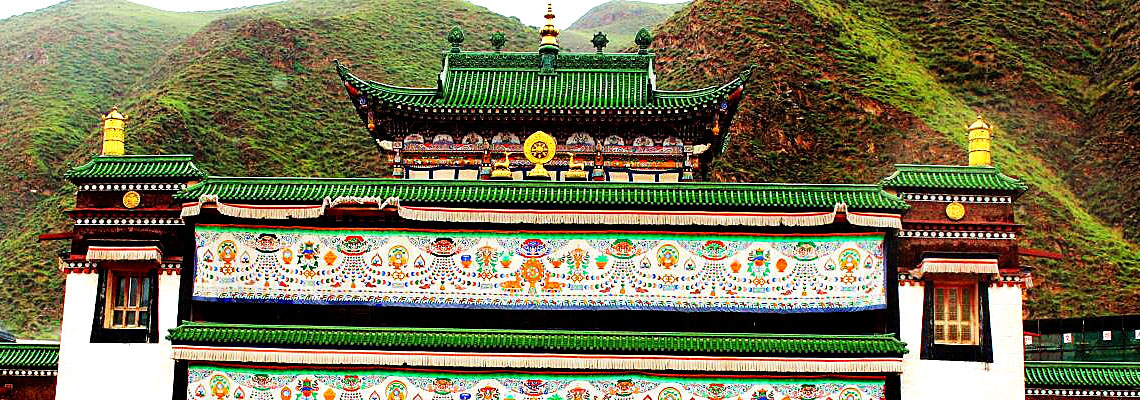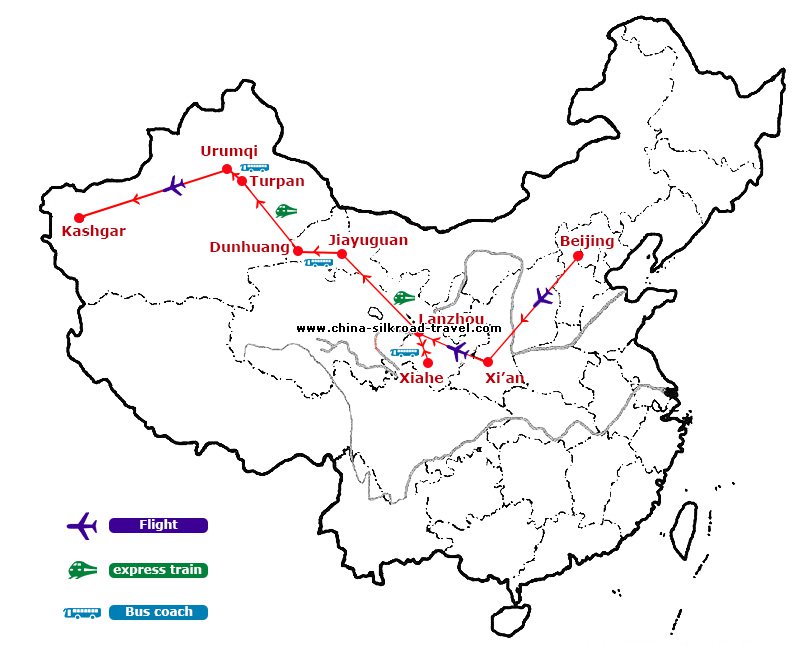
20th,April
Beijing
Please arrange for the international flight to get to Beijing. We will meet you at the Beijing airport, transfer you to the hotel and check you in. The rest of the day will be your free time to do a little exploration at your leisure.
Meals: None
Accommodation: In Beijing Super House International
21st,April
Beijing-
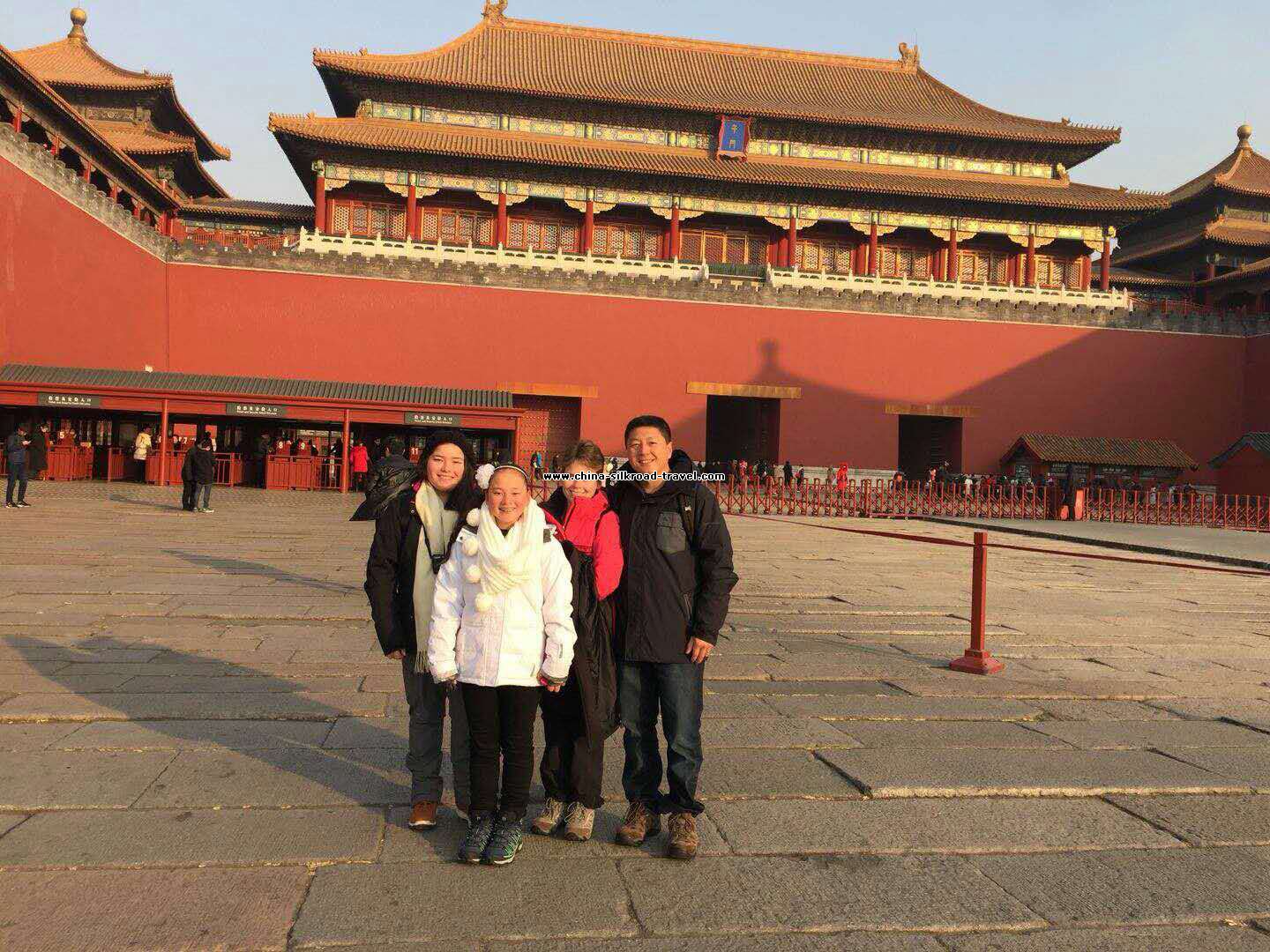
- Forbidden City
Today we will visit Tiananmen Square, the Forbidden City, and the Temple of Heaven. We will enjoy a Kungfu Show in the evening.
Tiananmen Square: Located at the centre of Beijing, Tiananmen, or the Gate of Heavenly Peace, is the largest city public square in the world. It was originally built in 1651 and in the 1950s it was enlarged to its current size, four times the original. It has great cultural significance as it was the site of a number of important events in the Chinese history, including the proclamation of the People’s Republic of China on October 1, 1949. It was named ‘Tiananmen Square’ because it is situated in front of the south gate of the Forbidden City - Tiananmen.
The Forbidden City: Located at the city center and called Gu Gong in Chinese, it was the imperial palace for twenty-four emperors during the Ming and Qing dynasties. It took 14 years to build during the reign of Emperor Chengzu in the Ming Dynasty (1368-1644). Ancient Chinese Astronomers believed that the Purple Star (Polaris) was in the center of heaven and the Heavenly Emperor lived in the Purple Palace. The Palace for the emperor on earth was so called the Purple City. It was forbidden to enter without special permission of the Emperor. Hence its name 'The Purple Forbidden City', usually just 'The Forbidden City’. Also called Palace Museum, the Forbidden City is recognized as the most magnificent and splendid palace complex in China and one of the five world-famous palaces, along with the Palace of Versailles in France, Buckingham Palace in England, the White House in United States, and the Kremlin in Russia.
The Temple of Heaven: Temple of Heaven, or Tiantan, is located in the southern part of Beijing, and has been one of the most sacred places for the whole country for more than five centuries. The complex was visited by the Emperors of the Ming and Qing dynasties for annual ceremonies of prayer to heaven, and is the largest one in Beijing among several royal altars to Heaven, Earth, Sun, Moon and other deities or symbolic forces of Nature.
Meals: None
Accommodation: In Beijing Super House International
22nd,April
Beijing-
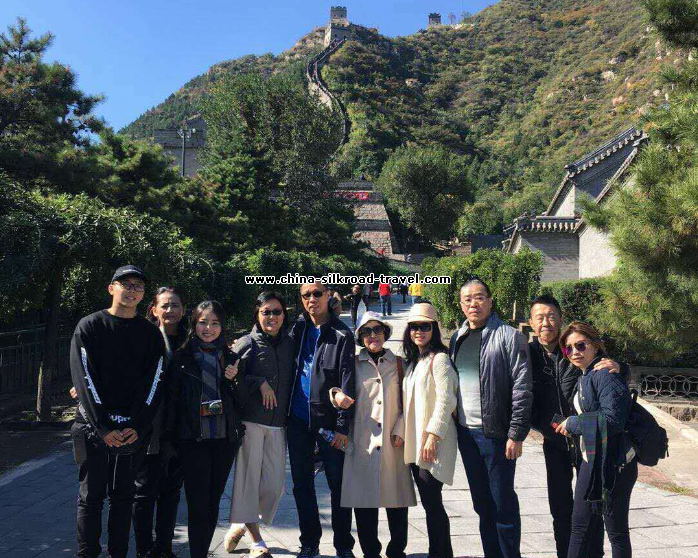
- Mutianyu Great Wall
Morning head to visit the Mutianyu Great Wall. then we will be visiting the Ming Tombs and Sacred Way.
The Mutianyu Great Wall : Lies in Huairou County, Mutianyu Section is 73 kilometers away from Beijing City. Commanding the strategic importance, Mutianyu Section is called as the Majestic Pass on Precipitous Mountains. It is one of the best-preserved parts of the Great Wall.
The Ming Tombs: Also known as the “13 Tombs”, this is a collection of mausoleums of the 13 out of 17 of the Ming Dynasty emperors. The tomb that can be visited is that of Emperor Wanli, who reigned from 1537 to 1620, and his two empresses. Unearthed in 1956, this is literally an underground palace located 27m below ground surface.
Meals: None
Accommodation: In Beijing Super House International
23rd,April
Beijing-
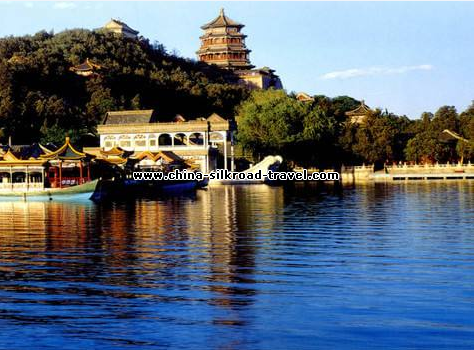
- the Summer Place
Today we will go to the Summer Palace, and cruise in the Summer Palace lake. We will also visit the Hutong district and Silk Street. After that we will send you to the airport for your flight to Xian.
Summer Palace: Situated in the Haidian District northwest of Beijing City, the Summer Palace is 15 kilometers from central Beijing. Being the largest and most well-preserved royal park in China, it has greatly influenced Chinese horticulture and landscape with its famous natural views and cultural interests. It has long since been recognized as 'The Museum of Royal Gardens'.
Hutong: It is said that the real culture of Beijing is the culture of the Hutong and Courtyards. That is so true. Hutong is a Mongolian word meaning water well. At nine meters wide, it is the term given to a lane or small street that originated during the Yuan Dynasty (1271–1368). These hutongs, or alleyways, are formed by lines of traditional courtyard residences. Many neighborhoods were thus formed, and the word hutong now refers to these neighbourhoods of alleyways. They have become representatives of local culture, thus it is the first choice for people who would like to learn about the local history and culture.
Silk Street: Silk Street, or Silk Market, is a prosperous shopping market in the Beijing Chaoyang District. It used to be an outdoor market, but is now a shopping mall, which accommodates over 1,000 retailers and is regarded as one of the symbols of Beijing together with the Great Wall, the Summer Palace, and roast duck. Many foreign visitors, including some celebrities, enjoy Silk Street for shopping or having their clothes tailor-made. The former president of the US, George Bush, once went there with his daughter to buy some silk robes.
Meals: None
Accommodation: In Xi’an Grand Dynasty Culture Hotel
24th,April
Xi'an-
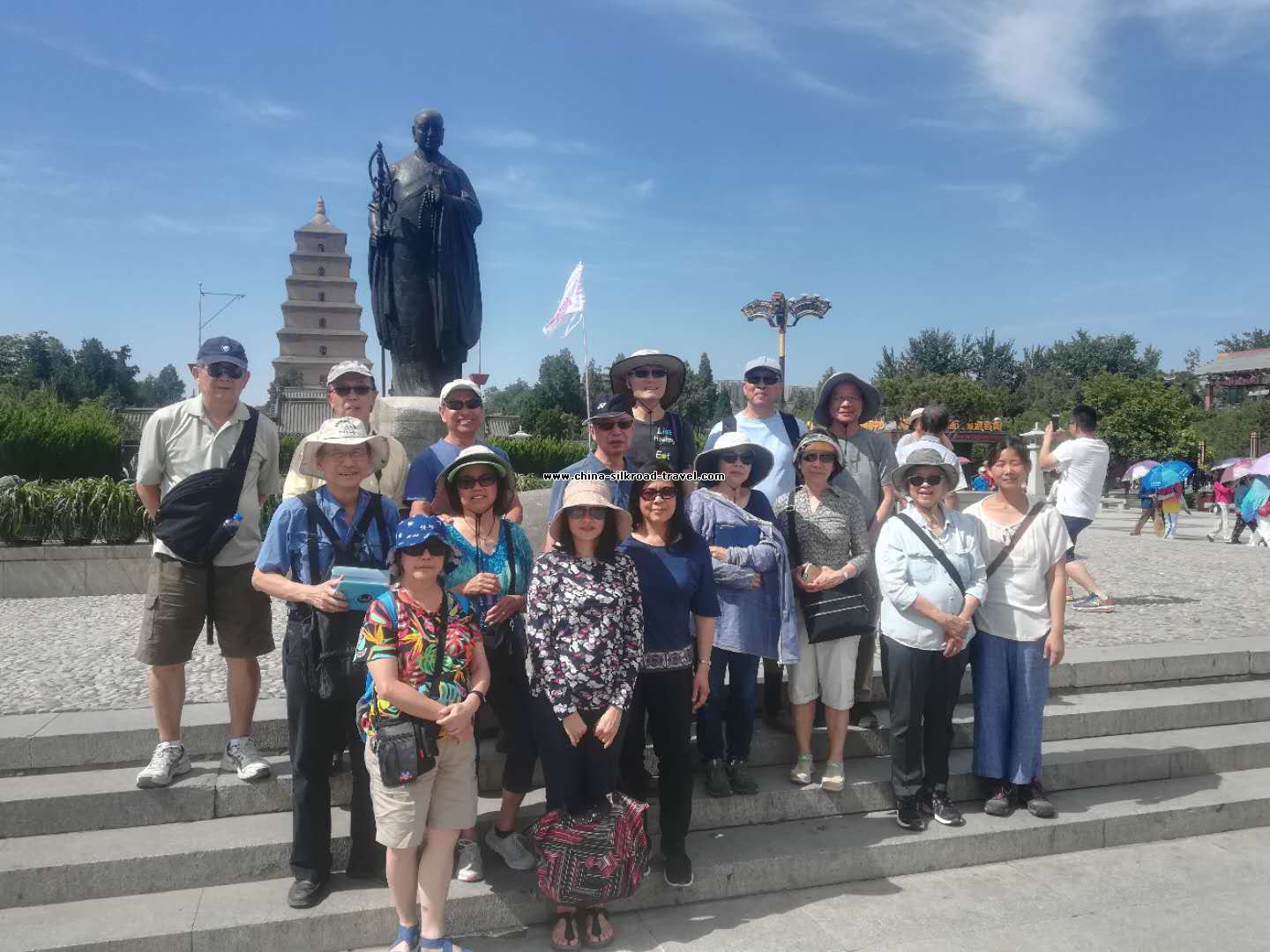
- Big Wild Goose Pagoda
Today we will visit the Terra-cotta Warriors and Horses, the Bell Tower and the Wild Goose Pagoda. We will enjoy the Tang Dynasty show in the evening.
The Terra-cotta Warriors and Horses: This is one of the greatest archaeological findings of the 20th century - the army of terra-cotta warriors and the bronze chariots entombed in vast underground vaults at emperor Qin Shi Huang's tomb from two thousand years ago. It is a sight not to be missed by any visitor to China. Emperor Qin Shi Huang ascended to the throne of Qin at the age of 13 in 246 BC. Under him, Qin conquered the other six warring states and became the first true emperor, or Shi Huang, of China.
The Bell Tower: This is the emblem of Xian city. It was used to keep time for the town and to sound alarms. This huge tower was originally built in the 14th century, and was relocated in 1739.
Big Wild Goose Pagoda: The Big Goose Pagoda is where the renowned Buddhist Master Xuanzang (Monk Tripitaka) stored his classics brought back all the way from India. The pagoda is one of the oldest structures in China. Originally it consisted of a brick structure of five storeys and was about 60 meters high. It was first built in 589AD during the Sui Dynasty. Between 701AD and 704AD during the reign of the Empress Wu Zetian five more storeys were added to the pagoda making it ten in all.
The Tang Dynasty show: This is the show that presents the palace dances and songs from the Tang Dynasty (618AD-907AD) when Xian was the capital of China.
Meals: None
Accommodation: In Xi’an Grand Dynasty Culture Hotel
25th,April
Xi'an-
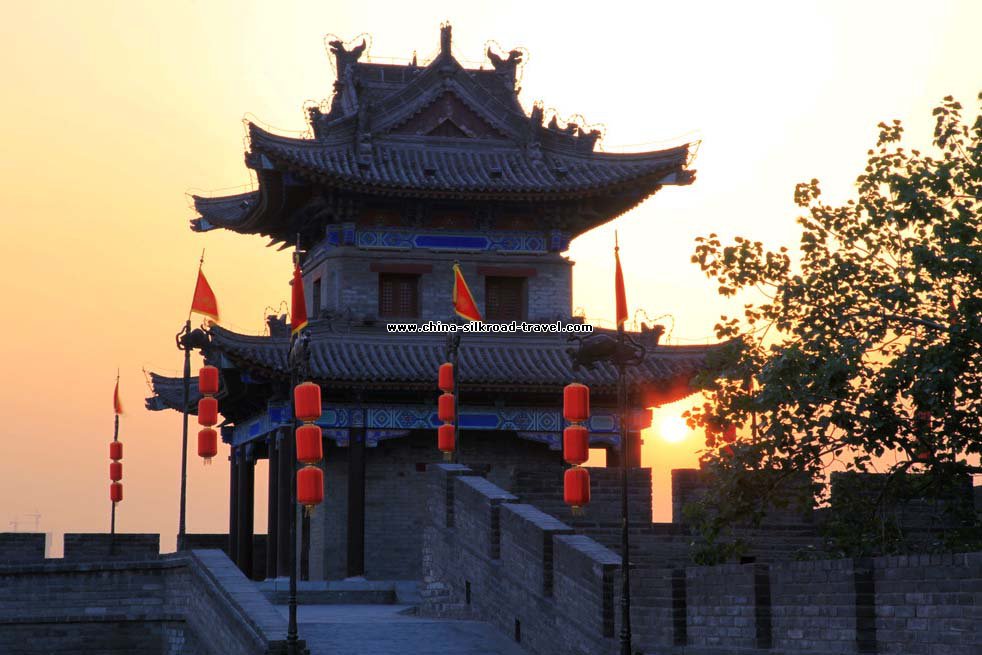
- Ancient City Wall
We will visit Shaanxi History Museum, Xian City Wall, stroll around the Muslim Street.
Shaanxi History Museum: This provincial museum is one of the major museums in China. It holds numerous unearthed cultural artifacts from within the Shaanxi province as well as the rest of China.
The Ancient City Wall: This is an extension of the old Tang Dynasty structure boasting the most complete city wall that has survived through the long Chinese history. The City Wall has corner towers, ramparts, sentry towers, gate towers, battlements and a number of city defensive fortifications with very strong defense capability.
Meals: None
Accommodation: In Xi’an Grand Dynasty Culture Hotel
26th,April
Xi'an-
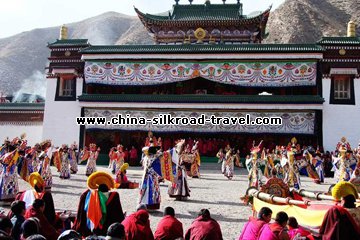
- the Labrang Monastery
Morning take the express train to Lanzhou, We will take a cruise by speed boat from Liujiaxia Gorge to Binglingsi to visit the Binglingsi Thousand Buddha Caves. then transfer to Xiahe. we will visit the Songke Grassland in the afternoon.
Bingling Thousand Buddha Caves: The Bingling Thousand Buddha Caves are on the cliff of Xiaojishi Hill. Located on a branch of Gansu part of the Silk Road, the Bingling Caves were started by Buddhist monks from as early as the West Jin Dynasty (265AD -316AD) although the official carving began in 420AD. Today there are 183 caves existing with 694 stone statues, 82 earth statues and murals of 900 square meters (9,688 square feet). Another pleasant surprise on your way to Bingling Caves is the beautiful Liujiaxia Reservoir. The crystal water lying among the yellow earth mountains is quite a sight. At the end of the Reservoir, the green water connects to the yellow water while the blue sky connects to the yellow earth. Perhaps this can only be experienced in Liujiaxia.
Songke Grassland: Lying at an average altitude of over 3,000m above sea level, the Songke Grassland is situated a short 14km from Xiahe. This vast expanse of grassy plains, covering an area of around 70 square kilometers, is a lonely, beautiful place that presents a nice change for those coming from the bustling cities, such as Chengdu or Lanzhou. There are only 4,000 Tibetan nomads left on the grasslands, and they graze yak herds and offer tourists the chance of a ride on their horses. Entertainment here varies according to your preference. Botanists and hikers will be happy to just set off into the rolling hills, but for those after a little more excitement, the horse rides, costing around RMB25, are good fun.
Meals: None
Accommodation: In Xiahe Nirvana Hote
27th,April
Xiahe-
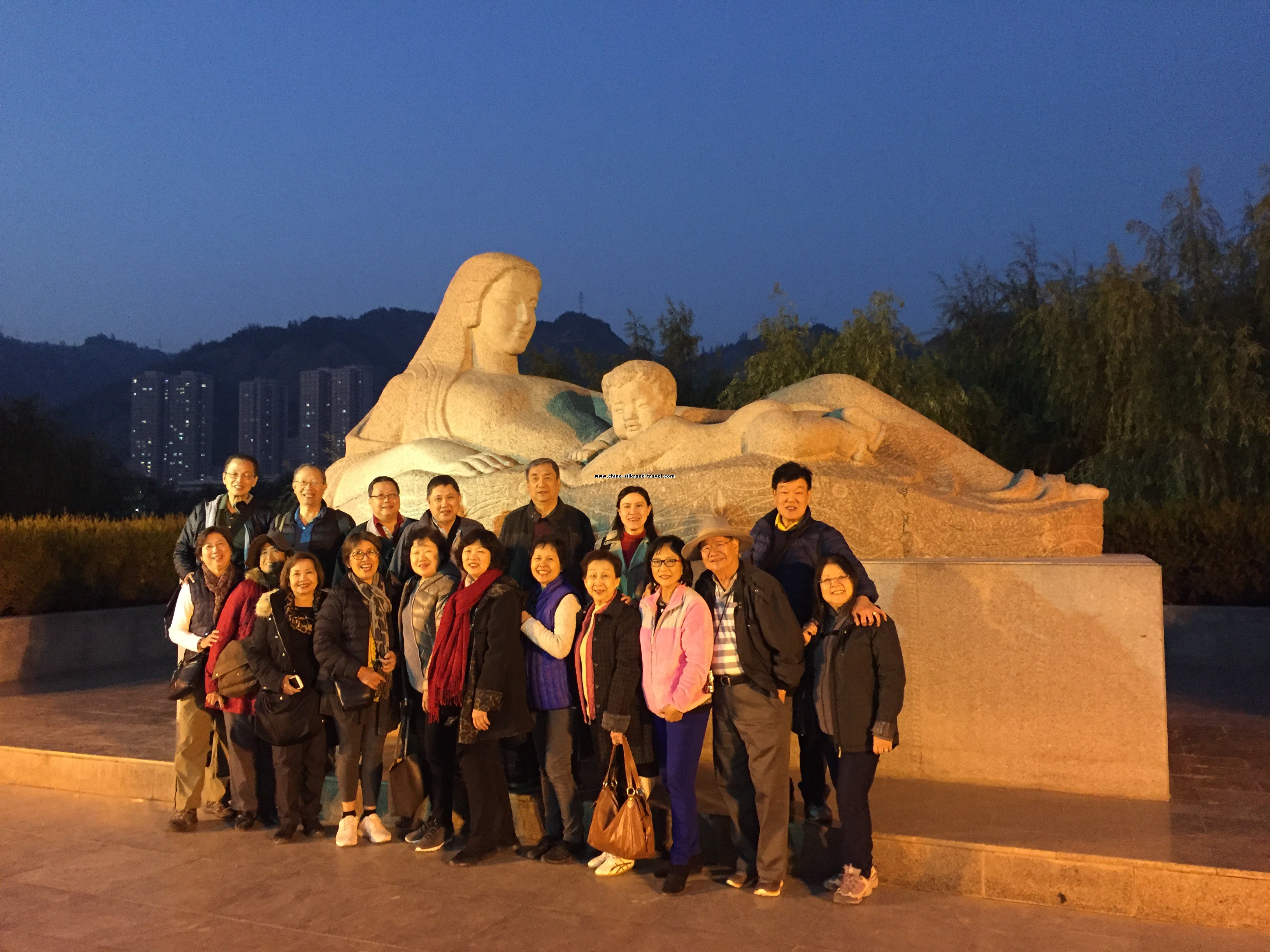
- the Yellow River Mother Sculpture
After breakfast, we will visit the Labrang Monastery, thereafter, we will go back to Lanzhou, have a Lanzhou city tour: visit the Yellow River Mother Sculpture. The sculpture comprises a mother and a baby, the mother with long hair, slim figure, lying on the undulating water looking happy and kind. Resting on her breast is a small child smiling naively. The Waterwheel Garden, the garden covers an area of 1.45 hectares (3.58 acres) and is comprised of two waterwheels, a cofferdam, the recreation area and a water mill house.
Labrang Monastery: The Labrang Monastery is located at the foot of the Phoenix Mountain, northwest of Xiahe County in Gannan Tibetan Nationality Autonomous Prefecture, Gansu Province. As a propitious place in the hearts of the Tibetans, it stands by the Daxia River and faces the Dragon Mountain. A long time ago, this place was a boundless sea, which over time had turned into the present landscape. There is a beautiful legend that tells about how the Dragon Mountain, Phoenix Mountain, and the Daxia River were formed.
Meals: None
Accommodation: In Lanzhou Legend Hotel
28th,April
Lanzhou-
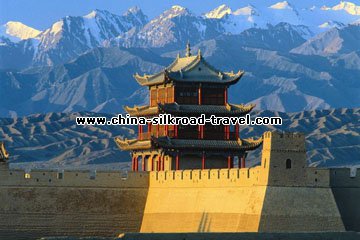
- the Jiayuguan Pass
Morning transfer to the station and take the express train to Jiayuguan. upon arrival, we will visit theJiayuguan Pass, Weijin Tomb.
Jiayuguan Pass: Jiayuguan Pass stands in the southwest part of Jiayuguan City, about 6 km away from downtown. The Ming Dynasty fort here guards the strategic pass, at the western end of the Great Wall – this was the last section built by the Ming Dynasty. Construction of the fort was started in 1372 in the Ming Dynasty, and subsequently enlarged and strengthened, and was known as 'the strongest pass under heaven'. It is located in the Jiayu Highland, hence its name Jiayuguan. It is situated between the Wenshu and Heishan Mountains at the foot of Jiayuguan Hill of the Qilian Mountain range.
Weijin Tomb: About 15 kilometers northeast of Jiayuguan, there are over 1,400 tombs which were built during the Wei and Jin dynasties (between the 3rd and 5th century). They feature brick wall paintings showing various social activities of the times.
Meals: None
Accommodation: In Jiayuguan Hotel
29th,April
Jiayuguan-

- the Crescent Lake
Today we will visit Yulin Grattoes, and then drive to Dunhuang. Arrive at Dunhuang, visit the Echoing-Sand Mountain and Crescent Lake. After dinner visit the Shazhou Night market.
Yulin Grottoes: The Yulin Grottoes lie 70 km to the south of Anxi County, Gansu Province. The Grottoes are chiseled into the cliffs on both the east and west sides of the Yulin River. The east cliff has 30 grottoes and the west has 11, with a distance of more than 100 meters between them. It used to be called Ten-Thousand Buddha Gorge. The grottoes began to be chiseled and sculpted during the Northern Wei Dynasty (386-534), and was enlarged in the later dynasties, such as Tang (618-907), Five Dynasties (907-960), Song (960-1279), the Western Xia (1038-1227), Yuan (1271-1368) and so on. More than 1,000 square meters of frescoes, and more than 100 colored sculptures are still extant there. The name Yulin (elm forest) came from the elms in the valley, and as you travel along the valley road you can easily imagine how it must have been to be a poet or brave solder in the distant past.
Echoing-Sand Mountain and Crescent Lake: Located 5 km (about three miles) south of Dunhuang City, the Echoing-Sand Mountain, for many Chinese well known as Mingsha Mountain, is celebrated for the sound of the moving sand. In 1994 it was acclaimed as the national key scenic spot. Together with the Crescent Spring and the Mogao Caves, the Echoing-Sand Mountain is most popular site in Dunhuang travel.You may wonder why the sand makes these different sounds. There is a legend that says how, in ancient times, a general with many soldiers came here to fight in a war with their enemies.
Meals: None
Accommodation: In Dunhuang Fuguo Hotel
30th,April
Dunhuang-
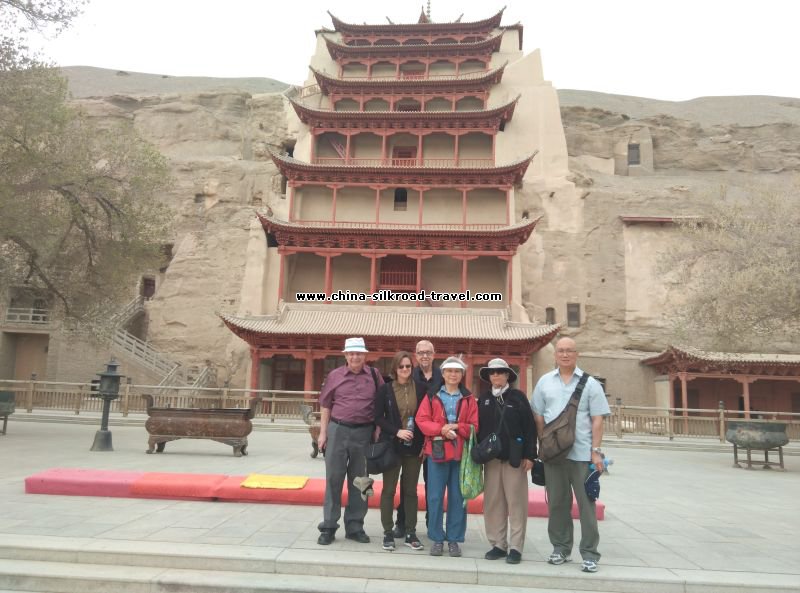
- the Mogao Grottoes
Today we will visit the Mogao Grottoes, After that we will send you to the railway station to catch the train to Turpan.
Mogao Grottoes: The Mogao Grottoes, a shrine of Buddhist art treasures, is 25 km from downtown Dunhuang on the eastern slope of Mingsha Shan (Echoing Sand Mountain). A network of plank-reinforced roads plying north to south 1600 meters long lead to the cave openings, which are stacked five stories high, some reaching up to 50 meters. Incidentally, Mogao means high up in the desert. According to Tang Dynasty records, a monk had witnessed onsite a vision of thousand Buddhas under showers of golden rays. Thus inspired, he started the caves construction work that spanned a millennium, from the 4th to the 14th centuries. What remains today is truly awe inspiring, and is likely the world’s richest treasure house of Buddhist sutras, murals and sculptures. Please note that cameras are not allowed inside the grottoes.
Meals: None
Accommodation: In Turpan Huozhou Hotel
1st,May
Turpan-
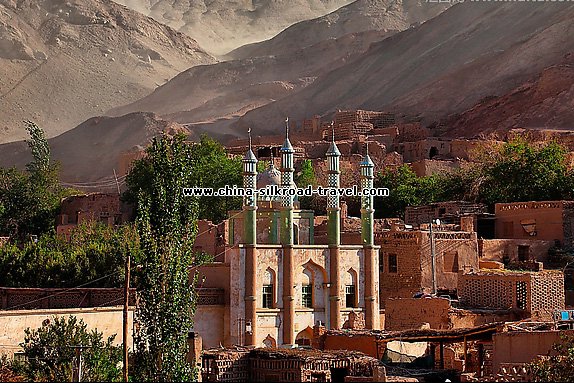
- the Tuyoq Village
Today we will visit the Jiaohe Ancient City, The Flaming Mountain, Karez Irrigation System, Sugong Minaret, and Tuyoq Valley.
Jiaohe Ancient City Ruins: The city's name means 'River City'. It was founded during the first century BC and abandoned during the 15th century. It is located atop a steep cliff on a leaf-shaped plateau between two deep river valleys in the Yarnaz valley 10 km to the west of Turpan City. It runs northwest to southeast, 1760 meters long and 300 meters across at the widest part. The ruins include city gates, streets and lanes, government office, temples, domestic houses, cave houses, wells, and an underground temple. It is part of the UNESCO World Heritage Silk Road Sites.
The Flaming Mountain: The Flaming Mountain is famously described in the classic Chinese mythological novel “Journey to the West”. It runs west from Shanshan County, is 98 km in length and 9 km across, with a relative height of 500 meters and the highest peak at 832 meters. The mountain is a branch range of the Bogda Mountain, formed in the orogenic movements of the Himalayas. This is the hottest place in China. The highest air temperature in summer is 47.8 degrees Centigrade, and the ground is over 70 degrees Centigrade in summer. Many years of volcanic activity have formed the unique crisscrossing gullies and ravines. During mid-afternoon the heat becomes intense as the sun's rays are reflected off the red rocks, as though the hillsides are engulfed by tongues of fire, hence the name.
Karez Irrigation System: The ancient Karez Irrigation System, which is still used today, is a unique irrigation system in Turpan. It takes advantage of the slopes, draws the underground water to flow by itself to irrigate farmland. It consists of four parts: vertical wells, underground channels, ground canals, and small reservoirs.
Sugong Minaret: Located in Mura Village 2km to the east of the city of Turpan, the minaret tower was built in the 41st year of the long reign of Qianlong Emperor during the Qing Dynasty. It is the embodiment of the ancient architectural arts of the Uighur people. The body of the tower is cylindroid in shape, built with bricks arranged in various symmetrical patterns on the outer wall. The tower has 14 windows and a spiral staircase inside going to the top.
Tuyoq Valley: This is a 12 km long primitive Uighur agricultural valley about 70 km from Turpan, with vineyards and fields in the northern and southern valleys and a narrow ravine that connects them. It is a Muslim religious pilgrimage site. The southern mouth of the valley has big Uighur mosques older than the Sugong Minaret and a cave thought by many to be described in the Koran. About a kilometer from the cave shrine is a group of grottoes that have some Buddhist and Nestorian artwork. These grottoes are said to date from the West Jin Dynasty (265AD-316AD), and are considered to be the earliest in Turpan. Most of the murals are damaged. Fortunately, 10 of the grottoes still have some of the preserved murals. These precious murals are very unique in style.
Meals: None
Accommodation: In Turpan Huozhou Hotel
2nd,May
Turpan-
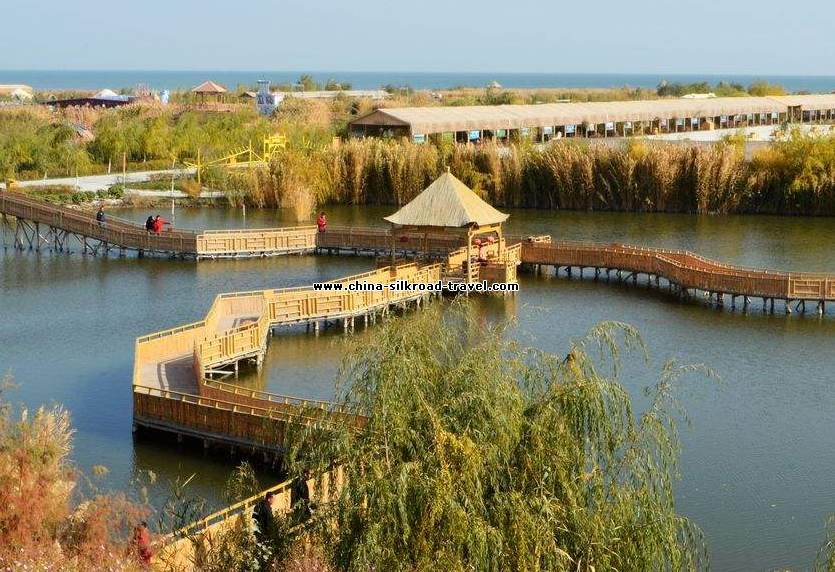
- the Bosten Lake
Morning breakfast at the hotel, drive in the deep of Tianshan Mountain, enjoy the beautiful scenery and drive to Korla, known as the "City of Pears" and the "City of Petroleum", enjoy the scenery of the Bosten Lake.
Meals: None
Accommodation: In Korla Loulan Hotel
3rd,May
Korla-

- the Diversifolius Poplars Park
Today we will drive to Kuqa and visit the Taklamakan Desert and the Tarim River in the Diversifolius Poplars Park.
Taklamakan Desert: The Taklamakan Desert is the biggest moving desert in the world and most of the people believe that it has buried most of good civilizations of central Asia. It occupies a land of more than 345,000 square km. Taklamakan in local Uyghur language means “Tha desert which buried some places under”. After some western explorers explored this desert in the early part of 20th century, they have given the name another meaning, which is “One goes, but never comes back”.
Diversifolius Poplars Park: The park is located in the north of Taklimakan Desert, and the middle portion of Tarim River. One can see Tarim River, poplar trees, the desert and the oil industry complexes. It is a good resort for sightseeing, entertainment, adventure, scientific expedition and vacation.
Meals: None
Accommodation: In Kuqa Hotel
4th,May
Kuqa-
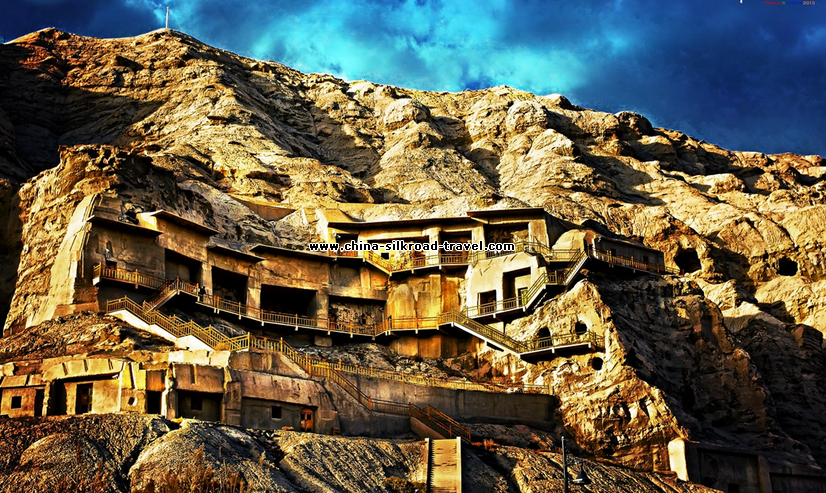
- the Kizil Grottoes
Today we will visit the Kizil Thousand Buddha Caves, Tianshan Great Canyon, Kizilgaha Beacon Tower, Subash Ruins and the Kucha Mosque. then take the overnight train to Kashgar.
Kizil Grottoes: Kizil Grottoes (Kizil being spelled variously as Qizil or Qyzyl) are a set of Buddhist rock-cut caves located near Kizil Township in Baicheng County, Xinjiang. The site is located on the northern bank of the Muzat River 75 km by road west of Kucha. This area was once a commercial hub of the Silk Road. The caves are said to be the earliest major Buddhist cave complex in China, with development occurring between the 3rd and 8th centuries. The contents of the cave paintings are very rich, including jataka stories, Buddha’s life story and the stories about karma. The Kizil Caves complex is the largest of the ancient Buddhist cave sites that are associated with the ancient Tocharian kingdom of Kucha, as well as the largest in Xinjiang.
Great Tianshan Canyon: Known as the most stunning Canyon in China, five thousand meters in total length, and two hundred meters in average depth, this great canyon was once the ancient river course for Kucha River. It would be a real treat for us visitors to take a half-hour walk in the great canyon to experience the gorgeous scenery.
Kizilgaha Beacon Tower: Located 10 km outside Kucha, the Kizilgaha Beaacon Tower provided security for traveling caravans on the Silk Road and prevented enemy invasions. Round earth tower built with a wooden roof, it rises to the sky in the middle of the desert landscape as typical scenery of the region. To ensure the safety of caravans on the Silk Road, the government of the Han Dynasty had installed watchtowers along the road. Among these towers, Kizilgaha is one of the oldest but also the best preserved of all. After more than 2,000 years, it still soars skyward. Almost 15 meters high, it was used not only to protect the caravans but also to prevent the Han Empire enemy invasions. During the day, smoke was triggered when the night a fire was lit.
Kucha Mosque: It is located in the north of the old city of Kucha and covers an area of 1165 square meters. With a capacity of 3000 people, it is the second largest mosque in Xinjiang. The mosque consists of a main worshiping hall, a small worshiping hall, a minaret, a qubbah, a religious court and hostels, etc. The mosque is a representative of Uygur architectural art of the Qing Dynasty.
Subashi Ruins: Located 23 kilometers northwest of Kuqa County, Xinjiang Province are the ruins of the Subashi Temple. The Ruins are divided by Kuqa River into eastern and western areas. These large area ruins reflect the temple's past brilliance. Subashi Temple was a Buddhism temple, which was built in the first century and reached its peak during the sixth to the eighth centuries in the Sui and Tang dynasties. In the Tang Dynasty (618 - 907), the hierarch Xuanzang was attracted by the splendor of the temple and the popularity of Buddhism in this area, and stayed here for more than 2 months on his way to India to get Buddhist sutra.
Meals: None
Accommodation: on the soft sleeper train
5th,May
Kashgar-
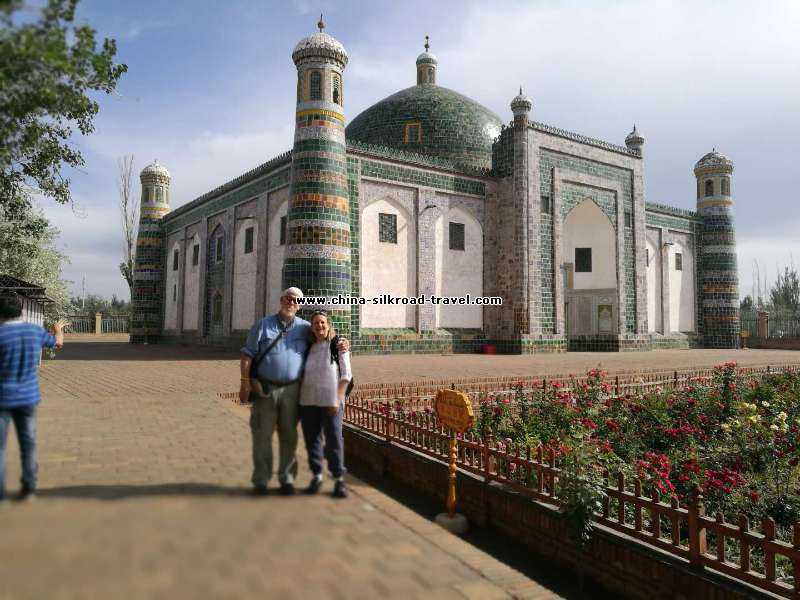
- the Idigar Mosque
We will meet you at the railway station to transfer you to the hotel and check you in. At noon we will take the city tour to explore the places.
Sunday Bazaar (Kashgar): This is called “Sunday” bazaar but it is open daily, even though it is busiest on Sundays. Streets near this big market are jammed with farmers and buyers arriving by donkey cart, truck, bicycle, horseback, ute, motobike, or on foot, with their animals. It is loud, lively and cheerful as they arrive, eat breakfast, set up their animals and check out the action. Cattle, sheep (they definitely look different), goats, donkeys, horses have their own sections. Sellers show off their animals as “good eaters” (most go as livestock, not meat). The entire experience is fascinating and fun.
Id Kah Mosque: This is the largest mosque in China, and the most famous mosque in Xinjiang. The construction of the mosque started in the middle of the 15th century, and the mosque has gradually developed to its present size. The buildings of Id Kah Mosque look magnificent and solemn, and display the artistic styles of Islamic mosque architecture. The Mosque has an area of about 16,800 square meters, consisting of the Pray Hall, the Koran teaching Hall, the Corridor, the Arches and other buildings attaching to it. The Pray Hall of the mosque, which can hold 4,000 prayers, is supported by 140 carved wooden pillars.
Apakh Hoja Tomb: This Mazar is the holiest place in Xinjiang for the Muslims, and an architectural treasure. Built in 1640, it is reminiscent of the Central Asian artistic style of Samarkand or Isfahan. The site is also known as the Xiang Fei (Fragrant Concubine) Tomb in memory of Abakh Khoja's granddaughter, Iparhan, who was the Fragrant Concubine of Emperor Qianlong of Qing Dynasty. A handsome blue-and-white tiled gate leads into the compound, which includes a small religious school and the Abakh Khoja family tomb. The latter is domed and faced with muti-color tiles. It is the most complete Islamic tomb dating from the beginning of the Qing Dynasty.
Handicraft Street : or Zhiren Street, is a fascinating place showing the distinctive custom and culture of Kashgar, with many full-time handicraftsmen working on the street and hundreds of workshops and booths alongside. This street is an exhibition for traditional Kashgar and mid-Asian handicrafts. Copper, metal, porcelain, woodwork, jewellery and other goods are seen to be made here and you will marvel at the incredible devices like the wooden objects that prevent babies from wetting the bed.
Old Town: Kashgar is an ancient city, and in walking the streets of its Old Town, one gets the sense of what this legendary Central Asian hub was like in the days when the Silk Road was at its zenith. 500-year old remnants of the city wall, narrow lanes and colorful multi-ethnic crowds combine to make Kashgar’s historic district a highlight of any visit to the city. Visit the small alleys to look at the characteristic Uygur residences. You will experience and enjoy the culture and history that has been retained in the small alleys and deep courtyards. In the alleys on platforms beside the residence you could marvel at the even more ancient primitive workshops for hand-made earthenware. Some 17 or 18 antique workshops have been restored.
Meals: None
Accommodation: In Kashgar Qinbag Hotel
6th,May
Kashgar-
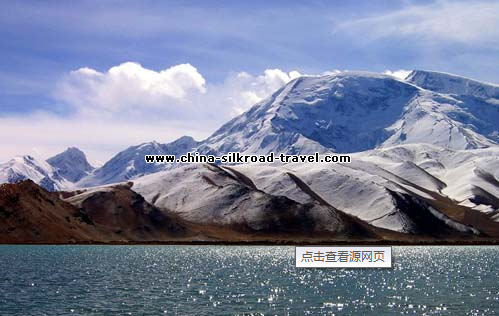
- the Karakul Lake
After breakfast we will head to Taxkorgan by coach to visit the White sand lake, Karakul Lake
White Sand Lake: The White Sand Lake is covered by the blown sand, and is always shining in the sunshine. This lake is on the way from Kashgar to the Karakul Lake.
Karakul Lake: At an altitude of 3600m, this is the highest lake of the Pamir plateau, near the junction of the Pamir, Tianshan (Heavenly Mountain), and Kunlun Mountain ranges. Surrounded by mountains which remain snow-covered throughout the year, the three highest peaks visible from the lake are the Muztag Ata (7546m), Konur Tagh (7649m) and Kongur Tiube (7530m). The lake is popular among travelers for its beautiful scenery and the clarity of its reflection in the water, whose color ranges from a dark green to azure and light blue. There are two Kirgiz settlements along the shore of Karakul Lake, a number of yurts about 1 km east of the bus drop-off point and a village with stone houses located on the western shores.
Meals: None
Accommodation: In Taxkorgan Crowninn Hotel
7th,May
Taxkorgan-
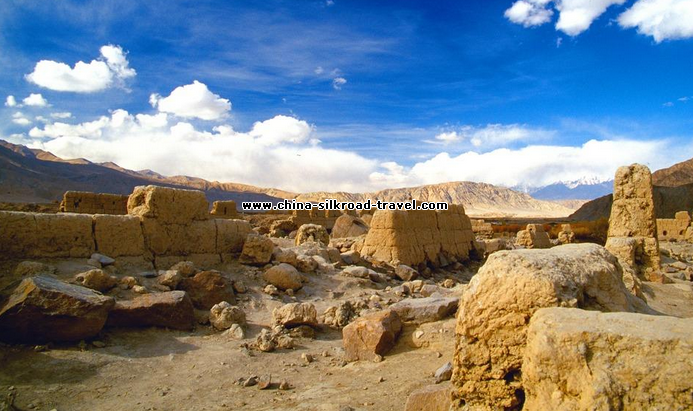
- the Stone Fortress
In the morning you will visit the Stone Fortress, After that we will return to Kashgar and take the flight to Urumqi.
Stone fortress: Located on a tableland northeast of the county seat of Taxkorgan Tajik Autonomous County, it covers an area of 100,000 square meters and consists of ruins of city and temple of the Tang Dynasty era and a Qing Dynasty government office. The temple occupied the eastern part of the city. In the western and southeastern parts are found ruined houses. On the ruins of the temple the Pulitin Office of the Qing Dynasty was built. The city is oval in shape, and the city walls were built with sun-dried bricks on stone foundation. It is 1285 meters in circumference outside.
Meals: None
Accommodation: In Urumqi Yilite Hotel
8th,May
Urumqi-
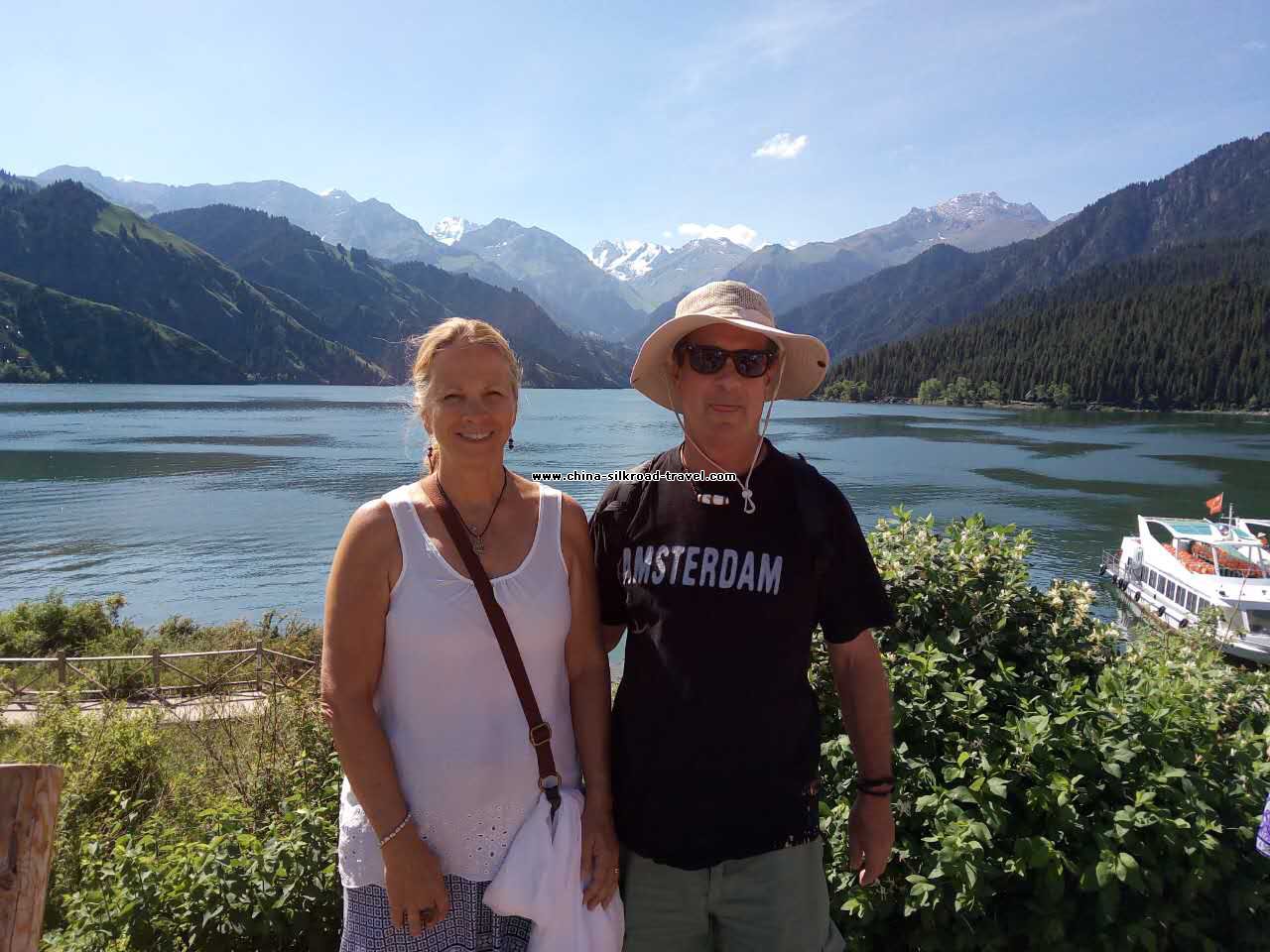
- the Heavenly Lake
We will visit Heavenly Lake, The Erdaoqiao Bazaar, Xinjiang Museum.
Heavenly Lake, a picturesque Alpine lake, 2000m up in the Tianshan mountain range. Heavenly Lake is a long and narrow gourd-shaped moraine lake, 3400 meters long, about 1500 meters wide, 105 meters at the deepest point, with an average depth of 40 meters, covering an area of about 5.9 square kilometers. There are eight beautiful scenic spots in the lake scenic area.
Erdaoqiao & International Bazaar: Here you will find a bustling market filled with fruits, clothing, crafts, knives, carpets, and almost anything that you can imagine. This is the largest bazaar in Urumqi, and is a place most welcomed by tourists, especially the ladies who will find they can buy some traditional Yugur cosmetics. On Sunday, there are more stalls and more goods to buy than any other day. The old streets around the bazaar are particularly worth seeing.
Xinjiang Museum: The Xinjiang Regional Museum is a large integrated museum and a centre for the collection and study of cultural relics in Xinjiang. The museum was built in 1953, featuring Uighur ethnic internal decor style and has an exhibition hall covering an area of about 7,800 square meters. There are more than 50,000 pieces of various kinds of cultural relics stored in the museum, among them are the ancient mummies represented by the “Loulan Beauty”, manuscripts in Chinese, Karosthi, Qiuci, Yanji, Tibetan, Uighurian and other characters prevailing in ancient western regions of China, as well as silk, wool, cotton and hemp fabrics and folk raiment, etc., all items of great intrigue. The 'Loulan beauty' mummy in particular is a well-preserved mummy from 4000 years ago. It still has a reddish brown skin, thick eyelashes, charming large eyes, and long hair.
Meals: None
Accommodation: In Urumqi Yilite Hotel
9th,May
UrumqiIn the morning you will leave Urumqi for your next destination. Airfare and tax will be on your own, but we can help you book the ticket, and the service is free.
| Departure Dates | Price Per Person | Hotel Single Supplement | Availability |
| 5360 USD | 910 USD | ||
| Paticipants | Join Us | ||
Service included:
√ Excellent English Speaking guide service
√ 4star hotel with breakfast
√ All the shuttle bus included in the itinerary
√ 2nd class express train: Xi’an to Lanzhou, Lanzhou to Jiayuguan .Dunhuang (Liuyuan station) to Turpan
√ 1st Class overnight train from Kuqa to Kashgar
√ Airfare with tax from Beijing to Xi’an, Kashgar to Urumqi
√ 2 bottles of water each person on daily use
Service excluded:
×some activities such as boating, horse riding etc
×Full board meals (lunches and dinners)
×International Airfare with tax (arrive in Beijing and leave from Urumqi)
×Other tours and any lost out of our control such as weather or flights

